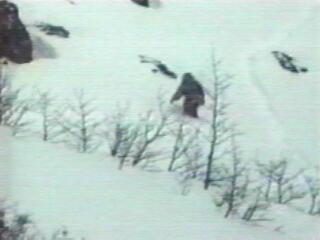|
|
The Snow Walker Video
 |
 |
In 1996, 2 hikers in the
mountains of Nepal took an amazing video of an ape like creature walking
upright along the slopes.
Could this be the evidence that the world has been waiting for? Above are
2
stills from that video.
 Footprint
of Yeti found by an expedition near Napal. Footprint
of Yeti found by an expedition near Napal. |
|
There are numerous articles, sightings and accounts of the "Abominable snowman/Yeti." This account of the "Abominable Snowman/Yeti" parallels that of "Big Foot/Sasquatch." Here are some interesting statistics on the "Yeti." The "Abominable Snowman/Yeti," like the "Big Foot's" of the North American continent, has been in existence for 6,000 years. There are no rivalries amongst the "Yeti" population. They also divide their family's with other "Yeti" families, to prevent in-breeding and depletion of their species. However, the similiarity ends there. Unlike "Big Foot," the "Yeti" did not evolve from an animal species, they evolved from the "caveman." They can be found in China, the Himalayas and on up into the former Soviet Union to Siberia. They are not related to "Big Foot." The total "Yeti" population is around 227. Their average life span is between 120 and 130 years. They are "carnivorous." They normally have 3 per family group and they live in caves. The number of family groups is unknown, at this time. The male is around 7 feet tall and the female, around 6 feet. The male's weight is between 300 and 350 pounds and the female is around 200 and 250 pounds. They forage for food during the daylight hours. The male does not live with the family, he is a "loner." He mates with a female, then leaves, and the female is left to raise the "off-springs. Stories of the Yeti vary in detail but
many of them suggest a creature with an apelike body and a human-like face.
Nepalese Sherpas have described the Yeti as having long, reddish-brown
hair all over its body. One Sherpa monastery exhibited a Yeti “portrait”
resembling the crossing of a wolf, tiger, and bear. Folklore describes
a fearsome, savage beast with a high-pitched whistling scream; a vile,
pungent odor; feet that point backwards; and supernatural powers. Superstitions
say that sighting the creature
Another name for the Yeti is metoh-kangmi, a term mistakenly translated into English as “abominable snowman.” That alluring name has stuck. The Yeti, which is supposed to live high in the Himalaya but has also been reported as far away as the European Alps, is said to prowl by night leaving huge footprints in the snow. Many expeditions have attempted to prove
the Yeti’s existence, but no scientific evidence has definitively confirmed
it. NATIONAL GEOGRAPHIC’s October 1962 article “Wintering on the Roof of
the World,” reports on Sir Edmund Hillary’s search for the Yeti. The famed
Everest pioneer’s expedition (which had other scientific goals) did document
a phenomenon that appears to account for “Yeti tracks.” In shaded snow
Hillary’s team found impressions resembling fox tracks. The tracks led
to a sunny area where melting had elongated the tracks into large human-like
footprints. Likewise, the
Hillary’s team was shown fur purportedly taken from the Yeti. Investigation revealed that it was fur from the rare Tibetan blue bear. A “Yeti scalp” was analyzed and found to have been the molded skin of a serow—a goatlike animal of the Himalaya. Hillary returned from the Himalaya believing that the Yeti exists only in legend. Or the abominable snowman as it is commonly called has been sighted in the Himalayan mountains for 100's of years. The creature is a tall manlike creature coverd with shaggy hair. The people of Nepal see the creature regularly. Accounts say it's height is approx. 6-8 feet, conical scalp, pointed ears, hairless chest area and a human-like face. The creature is said to have a very bad temperment and will attack anyone who ventures close enough. The Yeti's descriptions are similar to those of Bigfoot. Above is a photo of a footprint attributed
to the Yeti. Judging by the depth of the footprint impressions, the average
yeti most way upwards of 800 pounds. Many Westerners have also observed
this creature while on expeditions in the mountains. The most
recent sighting was in 1986 when the creature was observed by the famous
climber Reinhold Messner. In 1992, an expedition discovered the Yeti's
footprints in and around their camp when they awoke in the morning.
The areas in this region are not well traversed, so it is believable that
an unknown primate lives here and remains yet undiscovered by science.
|
 A
Closer "Blown Up" view of a frame from the video.
A
Closer "Blown Up" view of a frame from the video.
|
|